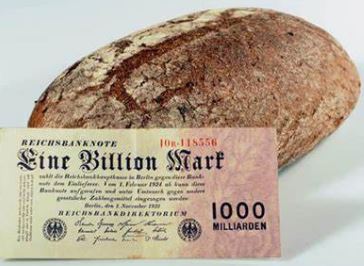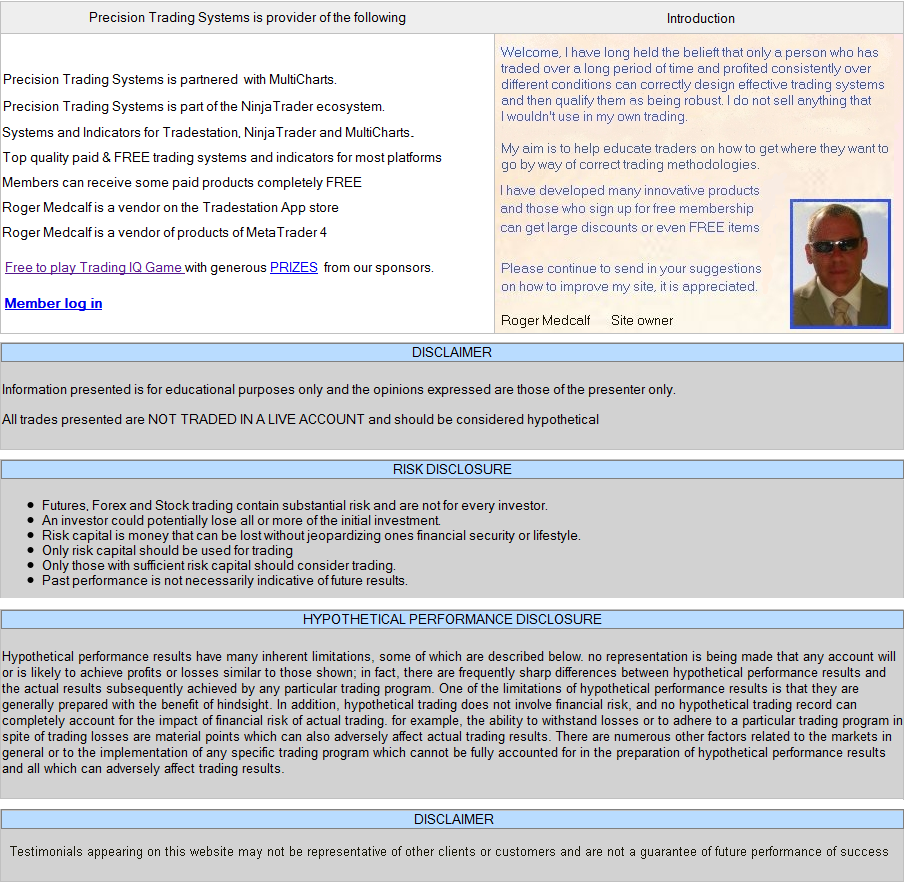The German hyperinflation of 1921-1923: The German economy
experienced a severe period of inflation and currency
depreciation following World War I, as the German government
struggled to meet its reparations obligations and finance
its domestic spending. The value of the German mark
plummeted by more than 99% during this
period, and the economy was eventually stabilized through
the introduction of a new currency, the Rentenmark.
200 Billion marks for a loaf of bread.
International
students were able to buy up entire streets of houses on
their allowances.
Yes seriously,
watch the video here

The Austrian hyperinflation of 1921-1922: The Austrian
economy experienced a similar period of inflation and
currency depreciation following World War I, as the Austrian
government struggled to meet its reparations obligations and
finance its domestic spending.
The value of the Austrian
krone plummeted by more than 99% during
this period, and the economy was eventually stabilized
through the introduction of a new currency, the Schilling.
The Hungarian hyperinflation of 1945-1946: The Hungarian
economy experienced a severe period of inflation and
currency depreciation following World War II, as the
Hungarian government struggled to meet its reparations
obligations and finance its domestic spending. The value of
the Hungarian pengő plummeted by more than 99%
during this period, and the economy was eventually
stabilized through the introduction of a new currency, the
forint.
The Chinese hyperinflation of 1948-1949: The
Chinese economy experienced a severe period of inflation and
currency depreciation following the end of the Chinese Civil
War, as the Chinese government struggled to finance its
domestic spending and stabilize the economy. The value of
the Chinese yuan plummeted by more than 99%
during this period, and the economy was eventually
stabilized through the introduction of a new currency, the
Renminbi.
The Argentine hyperinflation of 1989-1990:
The Argentine economy experienced a severe period of
inflation and currency depreciation in the late 1980s and
early 1990s, as the Argentine government struggled to
finance its domestic spending and stabilize the economy. The
value of the Argentine peso plummeted by more than
99% during this period, and the economy was
eventually stabilized through the introduction of a new
currency, the convertible peso.... and
...then
the Argentine peso crisis of
2001-2002: The value of the Argentine peso plummeted by more
than 70% during this period, as the
Argentine economy experienced a severe period of inflation
and currency depreciation.The Russian ruble
collapse of 1998: The Russian economy experienced a severe
period of inflation and currency depreciation in the late
1990s, as the Russian government struggled to finance its
domestic spending and stabilize the economy. The value of
the Russian ruble plummeted by more than 70%,
and the economy was eventually stabilized through the
introduction of a new currency, the new ruble.
The
Zimbabwean hyperinflation of 2008-2009: The Zimbabwean
economy experienced a severe period of inflation and
currency depreciation in the late 2000s, as the Zimbabwean
government struggled to finance its domestic spending and
stabilize the economy. The value of the Zimbabwean dollar
plummeted by more than 99%, and the economy
was eventually stabilized through the introduction of a new
currency, the bond note. At one point it cost 50 billion
Zimbabwe dollars to buy three eggs, this required a wheel
barrow to carry the money.
Off to buy some eggs in
Zimbabwe

The Venezuelan
hyperinflation of 2016-present: The Venezuelan economy has
experienced a severe and ongoing period of inflation and
currency depreciation since 2016, as the Venezuelan
government has struggled to finance its domestic spending
and stabilize the economy. The value of the Venezuelan
bolivar has plummeted by more than 99% ,
and the economy is currently in a state of crisis.
The Turkish lira collapse of 2018: The Turkish economy
experienced a severe period of inflation and currency
depreciation in 2018, as the Turkish government struggled to
finance its domestic spending and stabilize the economy. The
value of the Turkish lira plummeted
by more than 40%,
and the economy was eventually stabilized through the
introduction of a new economic program.
The Lebanese
lira collapse of 2019-present: The Lebanese economy has
experienced a severe and ongoing period of inflation and
currency depreciation since 2019, as the Lebanese government
has struggled to finance its domestic spending and stabilize
the economy. The value of the Lebanese lira has plummeted by
more than 90%, and the economy is currently
in a state of crisis.
The Greek hyperinflation of
1943-1944: The value of the Greek drachma plummeted by more
than 99% during this period, as the Greek
economy experienced a severe period of inflation and
currency depreciation.
The Polish hyperinflation of
1944-1946: The value of the Polish złoty plummeted by more
than 99% during this period, as the Polish
economy experienced a severe period of inflation and
currency depreciation.
The Yugoslavian
hyperinflation of 1992-1994: The value of the Yugoslavian
dinar plummeted by more than 99% during
this period, as the Yugoslavian economy experienced a severe
period of inflation and currency depreciation. This was
marked by a very sad scene of a man setting himself on fire
with petrol live on TV, this act of self immolation led to
riots and protests against the government. The man died as a
result of his burns.
The
Brazilian hyperinflation of 1986-1994: The value of the
Brazilian cruzeiro plummeted by more than 99%
during this period, as the Brazilian economy experienced a
severe period of inflation and currency depreciation.
The Mexican peso crisis of 1994-1995: The value of the
Mexican peso plummeted by more than 50%
during this period, as the Mexican economy experienced a
severe period of inflation and currency depreciation.
The Asian financial crisis of 1997-1998: The value of
several Asian currencies, including the Thai baht, the
Indonesian rupiah, and the South Korean won, plummeted by
more than 50% during this period, as the
Asian economies experienced a severe period of inflation and
currency depreciation.
The Icelandic krona crisis
of 2008-2011: The value of the Icelandic krona plummeted by
more than 50% during this period, as the
Icelandic economy experienced a severe period of inflation
and currency depreciation. If you remember, Iceland got a
very high credit rating by Moody's investor service just
prior to the collapse. The moral? Don't trust what is
written by anyone, anywhere.
The Ukrainian hryvnia
crisis of 2014-2015: The value of the Ukrainian hryvnia
plummeted by more than 70% during this
period, as the Ukrainian economy experienced a severe period
of inflation and currency depreciation.
The
Austro-Hungarian hyperinflation of 1921-1922: The value of
the Austro-Hungarian krone plummeted by more than
99% during this period, as the Austro-Hungarian
economy experienced a severe period of inflation and
currency depreciation.
The Bulgarian hyperinflation
of 1922-1923: The value of the Bulgarian lev plummeted by
more than 99% during this period, as the
Bulgarian economy experienced a severe period of inflation
and currency depreciation.
The French hyperinflation
of 1924-1926: The value of the French franc plummeted by
more than 50% during this period, as the
French economy experienced a severe period of inflation and
currency depreciation.
The Belgian hyperinflation of
1924-1926: The value of the Belgian franc plummeted by more
than 99% during this period, as the Belgian
economy experienced a severe period of inflation and
currency depreciation.
The Italian hyperinflation of
1921-1922: The value of the Italian lira plummeted by more
than 99% during this period, as the Italian
economy experienced a severe period of inflation and
currency depreciation.
The Romanian hyperinflation of
1921-1923: The value of the Romanian leu plummeted by more
than 99% during this period, as the
Romanian economy experienced a severe period of inflation
and currency depreciation.
The North Korean
hyperinflation of 1994-1996: The value of the North Korean
won plummeted by more than 99% during this
period, as the North Korean economy experienced a severe
period of inflation and currency depreciation.
The
Zairean hyperinflation of 1991-1996: The value of the
Zairean zaire plummeted by more than 99%
during this period, as the Zairean economy experienced a
severe period of inflation and currency depreciation.
The Peruvian hyperinflation of 1988-1990: The value of
the Peruvian inti plummeted by more than 99%
during this period, as the Peruvian economy experienced a
severe period of inflation and currency depreciation.
The Nicaraguan hyperinflation of 1988-1990: The value of
the Nicaraguan cordoba plummeted by more than 99%
during this period, as the Nicaraguan economy experienced a
severe period of inflation and currency depreciation.
The Bolivian hyperinflation of 1984-1985: The value of
the Bolivian peso plummeted by more than 99%
during this period, as the Bolivian economy experienced a
severe period of inflation and currency depreciation.
The Angolan hyperinflation of 1993-1999: The value of
the Angolan kwanza plummeted by more than 99%
during this period, as the Angolan economy experienced a
severe period of inflation and currency depreciation.
The Georgian hyperinflation of 1993-1995: The value of
the Georgian coupon plummeted by more than 99%
during this period, as the Georgian economy
experienced a severe period of inflation and currency
depreciation.
The Azerbaijani hyperinflation of
1993-1995: The value of the Azerbaijani manat plummeted by
more than 99% during this period, as the
Azerbaijani economy experienced a severe period of inflation
and currency depreciation.
The Uzbekistani
hyperinflation of 1993-1995: The value of the Uzbekistani
coupon plummeted by more than 99% during
this period, as the Uzbekistani economy experienced a severe
period of inflation and currency depreciation.
The
Tajikistani hyperinflation of 1993-1995: The value of the
Tajikistani ruble plummeted by more than 99%
during this period, as the Tajikistani economy experienced a
severe period of inflation and currency depreciation.
The Turkmenistani hyperinflation of 1993-1995: The value
of the Turkmenistani manat plummeted by more than
99% during this period, as the Turkmenistani
economy experienced a severe period of inflation and
currency depreciation.
The Kyrgyzstani hyperinflation
of 1993-1995: The value of the Kyrgyzstani som plummeted by
more than 99% during this period, as the
Kyrgyzstani economy experienced a severe period of inflation
and currency depreciation.
The British pound sterling
crisis of 1931: The value of the British pound sterling
plummeted by more than 25% during this
period, as the British economy experienced a severe period
of inflation and currency depreciation. The crisis was
triggered by a combination of factors, including the global
economic downturn, the high levels of government debt, and
the lack of confidence in the government's ability to manage
the economy.
Sri Lanka, the approximate start of the
currency decline was in the year 2000 to present estimated
to have fallen over 50% versus the US dollar and about 20%
in this last year. The petrol crisis continues to cause
distress to residents.
Forgive me if a few hundred
others got missed out.
THE VERY LONG LIST OF FIAT CURRENCIES THAT HAVE LASTED 100 YEARS OR MORE.
British pound sterling: Introduced
in the late 17th century, around 1694.
US dollar:
Created in 1782, "modified" in 1913 when the
federal resevere was created.
The Gold standard was abolished
in 1971, and the floating currency exchange rate regime was
adopted in 1973.
Canadian dollar: Introduced in
the mid-20th century, around 1858.
Swiss franc: Introduced in the late 19th century, around
1850.
Japanese yen:
Introduced in the late 19th century, around 1871.
Swedish krona: Introduced in the
late 19th century, around 1873.
Danish krone:
Introduced in the late 19th century, around 1873.
Norwegian krone: Introduced in the late 19th century, around
1875.
Yes, that is the end the
list.
Which currency will collapse next? When
will it start?
What is the meaning
of a fiat currency?
The term "fiat" is
derived from the Latin word "fiat", which means "let it be
done" or "let it be made", and it reflects the idea that a
fiat currency is created and maintained by the authority and
the power of the government or the central bank, rather than
by the inherent value or the scarcity of a physical
commodity.
In other words, "LET IT BE
PRINTED". A government can
just print more of it if they happen to be looking for more
cash.
Little do they care (or perhaps realize) they are
helping to destroy the future by instant gratification in
the present moment.
No fiat currencies have survived more than 350 years
yet. How surprising that is when governments
constantly reassure us they are competent.
About 95 years after the Federal
reserve was created in 1913 the dollar has declined to be
worth 4 cents in 2008.
Such is they manner of fiat
currency and the Fed.
The important question to ask is,
is it safe to hold fiat currency? Well not for long
periods as history teaches us.
Learn more about
hyperinflation and currency collapse
with these videos
NEW PRODUCT RELEASED
DEPTH GAUGE INTRADAY
FUTURES STRATEGY
Become a member of PTS and gain access to
lots of bad news, doom and gloom and trading systems that
work.
Sign up here.
Member log in
here to find your PTS Member ID number if you forgot it.





